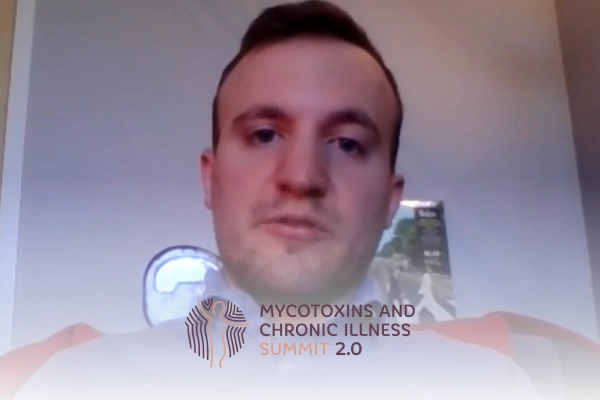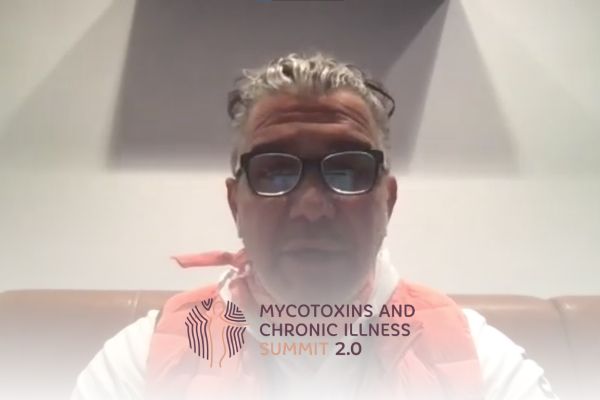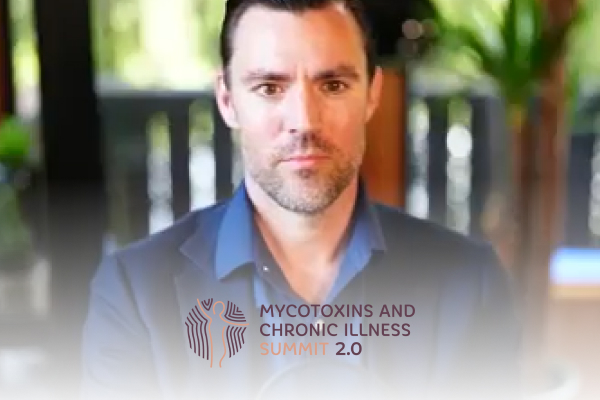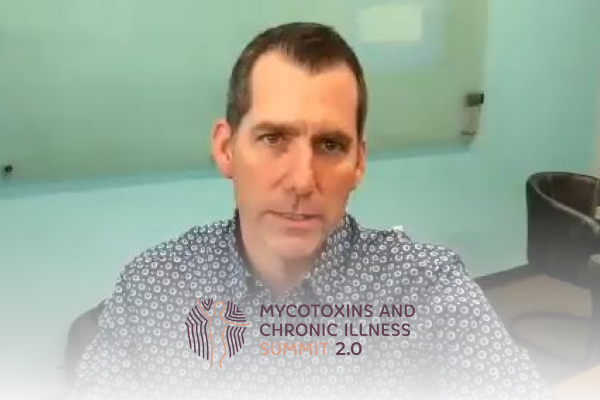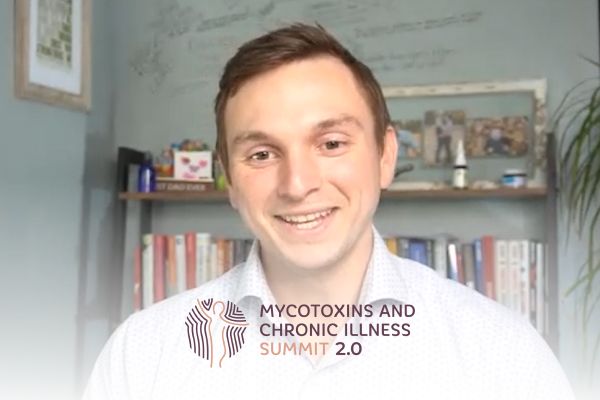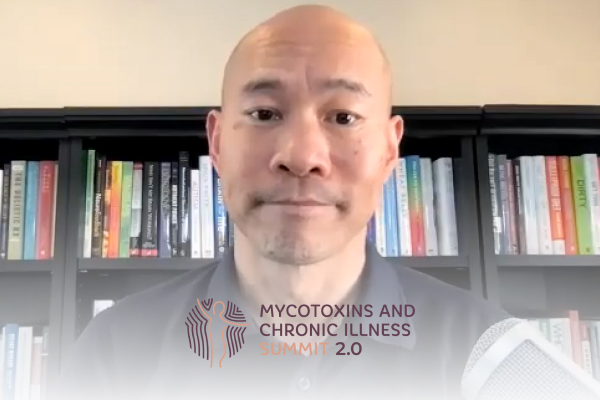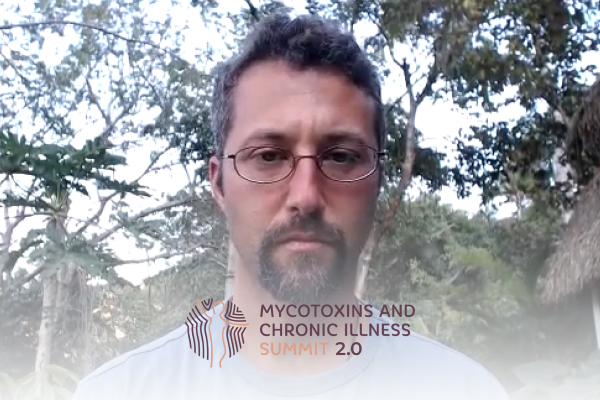Join the discussion below

Dr. Kunkle has a diverse skill set including (but not limited to): Lyme/infectious disease, autoimmunity, environmental medicine, pain management, hormone regulation, metabolic/weight loss optimization neuropsychiatric conditions to name a few. Dr. Kunkle is skilled in low dose immunotherapy and low dose antigen therapy for treatment of allergies, is trained in... Read More

Dr. Brian Plante is a licensed naturopathic doctor with extensive training in integrative healthcare approaches. He specializes in working with patients suffering from complex immune dysfunction such as Lyme disease, chronic viral infections, environmental toxicity (such as from mold and heavy metals), autoimmune disease, mast cell activation syndrome, and chronic... Read More
- How regular bowel movements are critical to removing toxins
- Negative consequences of untreated constipation in mold illness
- Ways to treat constipation, even when it is stubborn
Dr. Jamie Kunkle
Beings, I’m Dr. Jamie Kunkle I’m joined here by Dr. Brian Plante. We are gonna be talking about the gut today, but first I’d like to introduce Dr. Plante a little bit, who’s a colleague and friend of mine. I’ve actually worked with him extensively at our shared prior practice in the Sacramento area. Dr. Brian Plante is a licensed naturopathic doctor, he has extensive training in integrative healthcare approaches. He specializes in working with patient suffering from complex immune dysfunctions, such as Lyme disease, chronic infections, viral infections, environmental toxicities, including mold and metals, autoimmune disorders, muscle activation, chronic fatigue. He helps patients recover from functional gastrointestinal conditions, which is what we’re gonna be talking about today. Adrenal and thyroid disorders, neuropsychiatric as well. Yeah, and he conducts a comprehensive evaluation in order to get a complete picture and creates individualized treatment plans to address the patients specific concerns. He’s a graduate of National University of Natural Medicine in Portland, Oregon. Great school. And he’s an active member of ILADS, fellow ILADS member. Which is really cool as well. We’ll just dive right in though. Here I think we’ll talk more about Plante as we go. We’ll get a good sense of who he is. He’s really very smart, very sharp individual here with chronic diseases. He has the mind for it, for sure. As we know this can be difficult. So we’re gonna talk about mold and we’re gonna talk about the gut. The central place of our worlds sometimes, not always. It’s funny when somebody comes in without a gut issue, but it comes up. Well, let’s just say that. So please, let’s just dive right in here, Dr. Plante if you’re cool with it. Explain the mechanisms of toxin removal from the body. Tell me about this concept of amontaries too. Like how do people get these toxins out of their body? And then we’ll get into the gut specifically.
Brian Plante, N.D.
Yeah, that’s a great question. First of all, it’s a pleasure to be here. Dr. Kunkle has been an exceptional part of my training and work and with these conditions, and so I just wanna acknowledge that. And the gut is such a central place, as it pertains to chronic immune dysfunction. So much of our immune activity happens at the gut barrier in particular. And when it comes to lack of digestion of foods that can aggravate the inflammation at the gut barrier. And when it comes to improper ability to remove things from the gut, AKA constipation or dysmotility, we can have a buildup of toxins. And so I’ll go into that and talk about the amontaries, but just to kind of center attention on the gut as like the, one of, if not the primary arena where a lot of this stuff is taking place.
And so the amontaries I loved this concept when I was in naturopathic medical school, because there didn’t seem to be as much emphasis on it in conventional medicine, and it seemed so central to the idea of how do we promote optimal health, and the amontaries are the organs of elimination. And a lot of times these organs also have other functions that we tend to focus more of our attention on. And we forget that they’re actually really important in helping our body get rid of waste material. Whether that’s cellular/metabolic waste from our cells just doing their normal functions or whether to actually toxin removal of what we would call xenobiotics or substances that are foreign to the body. A lot of these are synthetic.
But also biological toxins, such as microbial wastes and mycotoxins. And so the amontaries, what are they? There’s the urinary system. So that’s gonna be the kidneys filtering the blood and that things come out through the urine. That’s the skin, which we often think about the skin as regulating temperature and moisture and protection and all that. But we don’t often think about the skin as an organ of elimination. We actually sweat out a lot of toxins. Mycotoxins, synthetic, organic toxins, and even heavy metals can be removed through the skin. The lungs interestingly enough. We exhale carbon dioxide primarily as a waste, but other substances as well.
This is kind of an aside, but garlic, the reason garlic breath is so difficult to get rid of is ’cause it’s not just in your mouth, it’s actually, we’re breaking down those sulfur containing molecules in the lungs and exhaling those. And so unless you were to nebulize or something, it’s kind of hard to get rid of that. Anyway, but then our feature system for today is the liver, the gallbladder and the large intestine, or really that whole integrated system, AKA the digestive system. But primarily the liver and biliary system. So what that looks like the blood is filtered, toxins are removed, they go through phase one and phase two metabolism in the liver. That basically is a process that allows the liver to… That allows these difficult to dissolve or remove toxins, to be more soluble and are able to be actually eliminated through of the body. And so that gets concentrated into bile, which is a kind of fat soluble emulsifier. That gets dumped through the gallbladder, into the small intestine, and then that goes through the GI tract. Now here’s where things get really interesting. If I may keep going I’m kind of-
Dr. Jamie Kunkle
Go for it.
Brian Plante, N.D.
Talking a lot, but where things get interesting is, our bodies evolve the ability to reabsorb bile. And this is called enterohepatic recirculation. And this is a really important concept, because it speaks to kind of why we need binders and why we need to kind of make sure things go outta the body, instead of recirculating. And so this was a incredibly adaptive mechanism that recirculation and conservation of bile when we weren’t getting that much fat in our diets. So when our ancestors were running around foraging, doing what they were doing, and maybe ate animal products on like a feast or famine type basis, you needed to conserve bile, because bile salts allow us to digest fat and, do a lot of other things.
The problem now is we don’t have that issue. And yet our bodies still will conserve bile and recirculate things. So any fat soluble toxins, which is most of what we’re talking about today that are dissolved in the bile, if those don’t get eliminated from the body they’re gonna recirculate. So not only is the bile, but everything dissolved in the bile is recirculated. And so that’s why we think about things like binders. Binders are gonna bind the bile salts, they’re gonna keep it in the intestinal tract, so then when you ideally have your bowel movement, the next day or later that day, stuff comes out.
Dr. Jamie Kunkle
Right, ideally having a bowel movement and binding, that sounds a little hard, if somebody’s having trouble having bowel movements. So, let’s maybe touch base on the elephant in the room here. When the system isn’t working very well, constipation, or slow motility, or the bile system’s not working, or the gallbladder, all that kind of stuff. So, we can highlight the constipation piece. So is that something you’re evaluating when you’re seeing these folks for the first time?
Brian Plante, N.D.
Absolutely. So that’s one of the first questions I ask is how often are you having bowel movements. In naturopathic school we learned this wonderful thing called the Bristol Stool Chart. If you’re not familiar, it’s a way of quantifying the consistency of stool from very hard and difficult to pass, to liquid, basically 100% liquid, on a scale one to seven respectively. We want type four, which is right in the middle. Well formed, not difficult to pass, not too loose, but so often we’re seeing chronic environmental toxin folks, including those with mycotoxic illness, not able to have daily bowel movements.
And this is one of the things that kind of pricks my ears to the possibility if they don’t have an obvious history of mold exposure, that makes me think, okay, if there’s some constipation going on in there, especially if it’s severe, like I’m having bowel movements once a week, or I’m having bowel movements like every couple weeks, I’ve actually heard that a couple of times, more commonly it’s like every two to three days, but even that is gonna affect our body’s ability to remove metabolic waste and anything if we’re incorporating binders. So if folks are constipated when they come in, giving them binders often makes things worse, unless they’re fiber-based binders. I learned a lot about these tricks from Dr. Kunkle.
We’ll talk about those for sure today, but like what kind of binders would you use when somebody constipated? That’s its own topic. But what are we doing in terms of they’re not having regular bowel movements, would you start them on a clay based or charcoal based or something like hyoscayamine type binder right away? And my experience is definitely not, because then that stops things up. There’s a doctor who does a lot of educational training who says, “When you’re doing a detox protocol, “constipation isn’t allowed.” And I always appreciated that. And so, what I will often do is make sure that we’re opening up those amontaries by giving things like digestive bitters. I can talk a little bit about how those work, magnesium citrate, sometimes ginger or 5-HDP, basically all these things that are gonna help jump start the nervous system and the blood flow to the GI tract and then soften stool with something like magnesium citrate, keep things moving, so stuff can get out before we start binding.
Dr. Jamie Kunkle
Yeah, no, I like that. So yeah, explain to the viewers here, how do bitters work exactly? Or how do some of these kinetic or motility agents work, here for the gut? And how are they also, if at all friendly to the process of detoxification?
Brian Plante, N.D.
Yeah, so bitters are truly exceptional in what they do and how they work is very interesting. So we have these taste receptors in our mouth that we would think about salty, sweet, bitter, sour, those kinds of things. But interestingly enough, the bitter taste receptors, not just in our mouth, they’re actually all the way through the GI tract. Which makes it interesting, it’s like, well, should we be even calling them taste receptors or are they doing something else? And they are doing a lot of things. And so what they do is when we taste bitter and it starts in the mouth and then goes through, it stimulates every stage of the digestive process.
So increased saliva production, increased stomach acid production, stomach enzyme production, pancreatic enzyme production, bile production, and then motility, which is movement of the intestinal tract, also known as peristalsis. It’s kinda like if you were to think about squeezing a tube of toothpaste from one end across the other, you have these smooth muscle contractions that are going throughout the GI tract and that’s moving food and ultimately moving stool. And so what bitter tastes do is they bind into those receptors and they stimulate all those processes.
And so you can imagine in our standard American diet, without very many bitter foods, this process can become impaired. That’s why a lot of folks like coffee. Coffee is probably the primary bitter food in an American diet if you’re not eating a lot of vegetables. Part of why we start our meals with salads is actually to do that. A lot of salad greens are bitter and they stimulate that. And so that’s kinda how bitters work. Bitters are my personal favorite for patients struggling with constipation. I’ve seen folks that are on opiates for pain or postsurgical recovery, and they’re using stool softeners, they’re using magnesium, they’re using laxatives, ginger sometimes everything but it’s the bitters that I see being the most impactful. And they tend to be very well tolerated even by sensitive folks.
Dr. Jamie Kunkle
Yeah, no, that’s awesome. I love bitters myself, a little bit goes a long way sometimes for people too. It’s fascinating. I know and it’s really interesting that so much of the digestive track responds to it. Not just taste of it, it’s like, I always think back to like essential oils, how like the skin has olfactory receptors like the skin smells, it’s like the gut tastes. It’s really fascinating stuff for sure. So yeah. So this constipation issue can be a really big deal in mold illness. And I think we discussed a little bit of the mechanisms to how it can be detrimental, but yeah. Could you elaborate a little bit on that end of things? How the constipation is not good for mold illness in this regard?
Brian Plante, N.D.
Yeah, so there are multiple mechanisms physiologically that can explain why mycotoxicity causes or aggravates constipation, hormonal dysfunction, especially the thyroid can affect motility. The nervous system, especially the vagus nerve attempts to affect motility. And so if there’s inflammation or dysregulation there, mycotoxicity tends to contribute to limbic over activation, which is that part of the brain that regulates the fear response and feelings of safety. And so if we’re in fight or flight all the time, or fight, flight or freeze, especially thinking about the freeze from like, okay, if the fight, flight or freeze, we could kind of go on a tangent with that. But the freeze response is, oh, this isn’t safe, I’m not gonna move.
When we think about that in the gut, it’s like, okay, well, I’m gonna hold on to stuff. I’m not gonna let things go, right? And so there’s the nervous system, there’s the endocrine system, AKA hormonal system, and then there’s inflammation at the gut lining. And so, especially if we’re getting molds from foods or from the respiratory tract, the sinuses and the nasal passages are interconnected with the gut, just the further down you go. And so oftentimes, these are things that are gonna contribute to dysmotility and lack of removal of things from the body. And then when we think, why is this a problem, well, it goes back to kind of what we were talking about earlier with the amontaries. And how the liver gallbladder and gastrointestinal tract as a way of eliminating toxin in the body is absolutely central.
I had a patient yesterday, ask me a phenomenal question, which is, if I can’t take a binder, can I still detox? What happens if I take all these cellular detox agents like luthione, vitamin E and calcium D-glucalate and phospholipids, and if I’m not taking a binder and I said, well, we are still detoxifying a little bit through this skin, especially if they’re doing a sweating practice and a little bit through the urinary system, but the GI tract and the liver gallbladder system is absolutely key. And so I will treat… I think it’s worth it to spend as much time as is needed to restore motility and regular bowel movements before binding, then kind of trying to skip step and say, well, let’s give you a bunch of detox agents that are gonna pull stuff out of storage, get them into circulation, and then have them have nowhere to go essentially. They just become recirculated as the bile gets reabsorbed. That and then of course there’s also a lot of microbiome dysregulation with folks. And so if you have microbes that aren’t so friendly, they’re gonna be secreting their own waste, and if you’re constipated, that stuff kind of builds up too.
Dr. Jamie Kunkle
Sure, so would you use probiotics in these cases too, or how would you help the biome?
Brian Plante, N.D.
That’s a good question. Sometimes, but oftentimes if there’s just motility and things aren’t moving, you end up with either a migration of bacteria from the large intestine where they’re supposed to be, upward into the small intestine, or if you have not enough stomach acid production, you can have bacteria that are supposed to be killed in the stomach, actually migrate downward into the small intestine. In either case it can cause what’s called small intestinal bacterial overgrowth, or SIBO, sometimes you’ll hear people say SIBO as well. And so SIBO can aggravate constipation. It also means there’s too many bacteria where they’re not really supposed to be. We have like a fraction of the amount of bacteria in our small intestine than we do in our large intestine. And so giving a bunch of probiotics to somebody with dysmotility can often aggravate that. But there’s an add to that, right?
So sometimes we think about spore based probiotics, which actually kind of kills some of the guys that aren’t supposed to be there. And so, there’s a nuance there, sometimes Saccharomyces boulardii which is a beneficial yeast, great probiotic to have on board when you’re doing antimicrobials that can flare people with mold sometimes, not always, but sometimes. And so, it can also help detox mycotoxins. So there’s definitely a lot of complexity that we kind of have to navigate, and just for our viewers not to overwhelm you, this is why it can be very helpful to have a health practitioner as your partner on this journey. ‘Cause he can help with that
Dr. Jamie Kunkle
Definitely. This can get really frustrating. You can read everything online that I have to be doing this binder, I should be doing this probiotic, or I should be doing this glutathione or something like that. And then every time we try to do this, it makes me feel worse or it makes me more constipated or something like this. We mentioned SIBO, that’s always an interesting one. Small intestine bacterial overgrowth, or in some cases, small intestine fungal overgrowth, which is interesting. That also can yeah, make a challenge, can it? In terms of binders and stuff like this. Fibers might be more reactive or something along these lines. How do you navigate some of those dynamics with SIBO?
Brian Plante, N.D.
Yeah, that’s a great question. So when we think about, and then we haven’t talked about fiber yet, interestingly enough, I’m glad that you brought that up.
Dr. Jamie Kunkle
Let’s talk about fiber then.
Brian Plante, N.D.
Let’s talk about fiber. Most of us have probably heard eating a plant, a high fiber, high vegetable diet is a great thing from a bowel regularity standpoint, from a colon cancer prevention standpoint from just an overall health standpoint. But this can cause a lot of folks to get into real bind when they have chronic GI issues. Where fibers can cause diarrhea or constipation, where they can cause gas and bloating, abdominal cramping, burping, those kinds of things. And a lot of that comes down to, what we would call fermentation. Which is the microbes in our guts say, Hey, “free food, this is awesome.” And they digest our the fiber from our food before we’re able to. And then that creates a lot of gas and a lot of distension and a lot of times abdominal discomfort.
And so giving a bunch of prebiotic fibers, giving a bunch high fiber vegetables, especially more fermentable ones to somebody with SIBO or SIFO, that’s the yeast or fungal overgrowth, that can sometimes aggravate. And so, you either have to find out what fibers that an individual can tolerate, or you can use something like the specific carbohydrate diet or the low FODMAP diet as like a guide to, okay, these are foods that are less fermentable and less likely to aggravate, And these are foods that I should be eating. ‘Cause we do want some fiber, especially if there’s constipation. We just need to find the right kinda fiber.
Dr. Jamie Kunkle
So what would be some starting fibers you would think of for the more sensitive situations here?
Brian Plante, N.D.
So the that’s a good one. The, caught me off guard just a little bit, I would just pull that one out if I’ve known. I haven’t gone low FODMAP with folks in a little while, but, that would be a really good starting point, I mean, they are less, better readily available, which are low FODMAP foods, but we could certainly have a… Which ones are used thinking of typically initially?
Dr. Jamie Kunkle
Oh yeah, for sure. I may not even start with, fibers entirely in those cases. I would have to say on a personal level. But in some cases I will kind of work into, some of them out there. But yeah, I will talk about that in a little bit though. It’s not a problem. We’re gonna move to a different avenue here. So, how about non-fiber stuff though? How about like gentle non-constipating non-fiber binders? Is that a possibility?
Brian Plante, N.D.
Yeah, so the non-constipating, non-fiber well, depends kinda who you ask, but I think about modified citrus pectin as not being a very potent, it’s not really too fibrous. Some of the formulations of it do have like polyols, there’re sugar alcohols and thing, especially the tablet versions of them, but, I’ll use a fair amount of modified citrus pectin it’s not a super strong binder, but it’s a fine place to start. Chlorella, a lot of folks do okay with. It can be constipating as well, if you take too much of it. And then there, some of the humic- fulvic, mineral blends. There’s a few brands that have developed more sensitive formulas that Dr. Kunkle and I have talked about. I don’t know if we can talk brands on this or not, but there are some out there, that are gentler.
I always try to frame that as this is a starting place and we’re working on your gut. Because we really almost often, almost always need some kind of charcoal or azilide or bentonite, or propamidine is getting a lot of attention nowadays. It’s not a super strong binder, but it does bind every type of mycotoxin according to the research. And so, I find having a rotational schedule with binders is key when it comes to mycotoxin removal, but it’s a journey. And so as Lao Tsu said, “The journey of a thousand miles “begins with the single step.” And so step one is let’s keep things moving. And even if there’s just a little, a gentler binder that we can start with, that’s better than no binder. And then we just kind of build on that, over weeks to months, depending on the progression that we’re seeing.
Dr. Jamie Kunkle
I know one concern I get with binders quite a bit from patients too, is like the two timing of the binder. Like what’s the best time to take the binder, or when should I not be taking the binder so to speak, am I gonna bind good stuff, Just as well as bad stuff? Could you speak to that concern?
Brian Plante, N.D.
Yeah. So it depends a little bit on the binder. It also depends a little bit on the person’s situation. And so, what I’m about to say, I learned from you actually, Dr. Kunkle. Which is, taking a binder at night is a great, if you have a gallbladder, right? If you don’t have a gallbladder, this doesn’t necessarily apply. But if you have a gallbladder, according to Chinese medicine, I’m sure you can elaborate this more than me, but according to Chinese medicine, the gallbladder is most active during that 24 hour cycle of 11:00 to 1:00, 11:00pm to 1:00 am. Am I remembering that correctly?
Dr. Jamie Kunkle
Yeah, the gallbladder has… Yeah, that’s 11:00, yes, that’s great.
Brian Plante, N.D.
There appears to be, kind of a gallbladder dumping of bile that happens in a more pronounced way during the night when we’re sleeping. And so if folks aren’t taking… If I have folks who need a lot of sleep support medication or supplement wise, then I may have them take a binder in the evening, at least an hour to an hour and a half, sometimes even two hours, depending on what their motility looks like before they take anything else. And so, if a patient’s not able to take a binder right before bed, ’cause they need to take other things, I’ll have them take it between dinner and bedtime, essentially. If they don’t have a gallbladder and they’re that way, in cases like that, bile is just kind of always draining into the intestinal tract, that time is less important.
I know there are some protocols where binders are dosed in the morning. Because that’s a little bit easier logistically. First thing in the morning, you take it an hour and a half to two hours away from anything else, and that’s a strategy that’s fine as well. And so from a clinical standpoint, I haven’t necessarily seen dramatic differences. It’s more a matter of logistics and what’s feasible for that person. We’re also often trying to juggle many supplements. Sometimes that’s an understatement in folks with chronic mycotoxic illness, and so we’re weighing those factors as well.
Dr. Jamie Kunkle
Yes, very interesting. So to say you fix the constipation here, now we’re kind of getting things moving along as far as that goes. What do you wanna step up in the gut? Like what’s your ideal sort of end game for approaching the gut in these type of cases? Aside from just what we’ve already discussed. Motility, yes very good.
Brian Plante, N.D.
So, a lot of it depends on… So it’s a thorough assessment. A comprehensive individualized assessment is key. And so, if somebody’s complaining of gastrointestinal symptoms, that’s gonna really hone my attention in on saying, okay, we need to figure out what’s causing this. Is there dysbiosis by AKA imbalance of the microbiome, that can include opportunistic organisms, that don’t cause issues for everybody, but when the immune system is stress, they cause issues. That could include frank pathogens, which are bad guys that are never good to have. Salmonella, Campylobacter, other there’s many that we could talk about parasites for sure, are consideration there as well. And so, assessing the microbiome in folks of gastrointestinal issues, we could do a whole talk on just parasites.
So as I said that, I’m like, oh, that’s a whole topic in the limits of testing for parasites, but basically evaluating whether or not they’re pathogens or dysregulation in the microbiome. Evaluating how much inflammation is in the GI tract. Are we dealing with inflammatory bowel disease, or are we dealing with more subclinical inflammation from food sensitivities, from, like I said, the microbiome being dysregulated can cause increase in inflammation at the GI lining irritants, right? So if somebody doesn’t have a gallbladder and they’re draining bile all day, that can cause irritation, and when that causes symptoms, it’s known as bile acid diarrhea. And so sometimes we see that.
The stomach acid production, gastro digestive enzyme production, these are all factors that play a role. And so I’ll often do a stool test, I’ll often do food sensitivity testing or at the very least a trial elimination diet, which is where you remove for a temporary period, usually four to six weeks, of common environmental, common food triggers for folks. And to be clear, these aren’t necessarily allergies, in the sense of when I ate this food, I need an EpiPen immediately or something very bad is gonna happen, but more low grade delayed type immune, what we call hypersensitivity reactions. And these can all stress the gut and the microbiome can contribute to leaky gut, that kinda stuff. And so, I’ll often do a stool test, a food sensitivity test, and a SIBO breath test. You drink this drink and you collect breath samples at certain intervals and it basically sees how much you’ve gut ferments it and what types of gas you produce. And then that will kind of tell us what types of bacteria are potentially overgrown.
So, comprehensive assessment is the short answer. And then treating that, treating each individual, and we have a variety of tools to do that. And so if there is leaky gut or impaired intestinal barrier function, it’s the same thing, just more technical. We’re gonna do things that are gonna help soothe the GI lining and repair those tight junctions. If it’s really inflamed, we’re gonna give anti-inflammatories that are primarily focused on the gut. If it’s microbiome related, we’re gonna give things that, I call it weed seed and soil. It’s like you give antimicrobial herbs often, sometimes even antibiotics to get the bad guys out. That’s the weeding. And then there’s the seeding. I like spore based probiotics for that, ’cause they tend to not aggravate. Sometimes sensitive folks, especially folks with more toxicity, you just have to go really slowly with dosing that, opening up the capsule, that kind of thing. And then the soil, we could kind of talk about this a little bit.
But there’s some interesting work with a company in Portland working on fecal derived postbiotics, Which are postbiotics are basically metabolic, beneficial metabolic byproducts of the microbiome. When you have a healthy gut, a healthy microbiome, they’re gonna be co-digesting our food with us, but it doesn’t cause issues, it actually is really health promoting. And so I won’t necessarily go too into that. But there there’s some thinking about postbiotics is kind of the short answer of the soil.
Dr. Jamie Kunkle
Yeah, right on. No, I like that, that’s awesome. So do you feel like getting the biome in balance is also going to help us detox then?
Brian Plante, N.D.
Yeah, absolutely. And so, the microbiome can be our friend, or it can be our foe. And so, if folks are having microbiome dysregulation, as I touched on earlier, they’re also generating a lot of waste. They’re like you could have good bacteria that generate beneficial things, which we call postbiotics, that’s technically still waste, but it’s waste that’s good for us. It’s like, just like trees, they utilize carbon dioxide then release oxygen. For them oxygen is their waste, but it’s good for us. And then we release our waste, which is carbon dioxide, which is good for them. And so all throughout nature, we see these symbiotic relationships where these organisms work together. And our microbiome is so central to our health.
There’s a great book on this topic called ” The Mind Gut Connection” by Emeran Mayer, he’s a functional gastroenterologist, that goes into the science of how our microbiome, throughout the body, 10 microbial cells, there’s 10 microbial cells for every one eukaryotic human cell. The metabolites circulating in our blood, there’s a hundred of those from microbes for everyone human. So we’re an ecosystem, we’re not even an organism in the sense of being isolated from the natural world. And so the health of the ecosystem is the health of us. And so if the microbiome is not working for us, it is often a detriment to health and there’s a whole lot we could get into about how best to do that, but those are kind of the foundations to think about.
Dr. Jamie Kunkle
Right on, yeah, the microcosm and the macrocosm also here. Speaking of the macro, we mentioned diet a little bit, and kind of our broader environment around us and kind of maybe how that plays a role in these illnesses. And I know that a lot of folks express concerns about certain things in the diet, maybe containing mold or worsening mold syndromes or something like this too. How do you, without getting into, obviously it’s completely individual, but as a superficial point of discussion, how would you approach an ideal diet for the gut, for detox, for avoidance of mold related sensitivities?
Brian Plante, N.D.
Yeah, great. So I direct my patients to Jill Castle’s work. She’s done some truly exceptional work in paving the road for treating multi toxicity and all the naturopathic pillars like diet and lifestyle that go into that. And she has some great information on mold free diet or–
Dr. Jamie Kunkle
And I believe she’ll be interviewed as well during the summit. So you’ll get a chance to talk to, we’ll wait a chance to talk to Dr. Jill as well. I’ll talk you to Christa.
Brian Plante, N.D.
Great. Then I don’t wanna barge in of her work, but she has some great handouts on lower mold diets. And so things like nuts and mushrooms for some folks can be aggravating, with produce it’s tricky, ’cause there’s so many good things in vegetables, like the sulforaphanes and the glucosinolates and sulfur containing compounds that are gonna increase glutathione production in the liver and really end the fiber, all that stuff’s really good, but you don’t want anything that has visible mold on it. Which kind of almost goes without saying, but sometimes things that are sitting in those moisture dens in the produce department, that can be a factor that we think about as well.
And so diet, I mean, I just wanna acknowledge, diet when you’re chronically ill, it can be very stressful. We wanna do the best that we can. Is kind of what I throw, what I offer patients. Which is let’s work together and figure out what foods you tolerate from a digestion standpoint, and then let’s work together to try to minimize exposure to foods that we know are high and mold and then we focus on foods that may have some mold, but getting them out, minimizing exposure, airborne exposure seems to be kind of the, at least for me, that’s what I focus most of my attention on for folks.
Dr. Jamie Kunkle
Yeah, making sure their environment’s safe. I’m going a little off script understandably here. This is another question I get a lot though, too is, when is it that my mold is actually like infecting me or not, maybe not infecting me but colonizing me? Like in my gut. At what point do you think about maybe treating mold as a sort of infection or something like this, what is it your sense of that?
Brian Plante, N.D.
Yeah, so the way I was trained and then kind of the way that I have kind of, seen that play out is you don’t wanna start antifungals too early. And somebody who already has a high mycotoxin burden, ’cause if there is colonization of mold or yeast even candida can produce certain microtoxins in the gut or in the sinuses and you start nuking them and they’re gonna be releasing their mycotoxins. And then if somebody already has a pretty full toxic bucket that can overflow and they can feel a lot worse. And so I’m almost always one making sure they’re having organ bowel movements, then starting them on binders, thinking about antifungal herbs, those tend to be more gentle.
When we’re doing binders and we’ve been doing them for a while and we’ve know that we’ve gotten them out of their moldy environment, which sometimes is easier said than done, if they’re not substantially improving or if they hit a plateau, that’s when I’m really thinking about colonization. I’ll often preemptively assess their gut and their sinuses. I’ll do a sensitive nasal culture that assesses for multiple antibiotic resistance stuff, as well as fungal colonization. We may not always see fungal colonization. The lab we work with, I love because they’ll actually keep the fungal culture for an additional two weeks, if it doesn’t grow in that first time. And so it does improve the sensitivity. Sometimes I do see it.
But there are other times where it’s like, this I’m really suspicious of colonization, but we’re not seeing it on the culture, do we still treat? And so I’ll do a lot of nebulizing, there are certain nasal sprays that can be helpful. Nasal ozone can be helpful, as long as you don’t inhale it in your lungs, I would recommend that you talk to a doctor if you’re thinking about doing nasal ozone and insufflation. And then, gastrointestinal antifungal stuff is gonna be herbs, prescription nystatin, and then there’s the systemic antifungals, like the azole antifungals or liposomal herbal formulations.
Dr. Jamie Kunkle
Yeah, right on. No, I like that. Yeah, there comes a time where that conversation may come up in this journey, it’s true. But first things first get in the gut and work in order. So that’s what we’re looking to do here. So yeah, very helpful here. So you and I are both naturopathic doctors too, and some things… I consider us both integrative too. Maybe we do a little bit of this in a little bit of that and all this kind of thing, but I really like our naturopathic roots, and background too. And I’d love it if there’s anything else you could add from a naturopathic perspective here on that we haven’t discussed yet that for treatment, for approach, for understanding these illnesses and how to get them moving in the right direction.
Brian Plante, N.D.
Yeah, so there may be other doctors, or other speakers in this conference had touch on this, but I just to kind of wet your appetites a little bit, the limbic activation and the PTSD and the anxiety component is what I see to be one of the primary obstacles to full recovery from mycotoxic illness. And this is one of those things that I didn’t focus a lot of attention on initially, I was very focused on treating, on everything we’ve talked about today. But what I’ve seen is that there tends to be significant anxiety, and this is very understandable. If my home isn’t safe, if my brain is inflamed, if my gut isn’t working, if I don’t know what to eat, all of these things are gonna contribute to hyper-vigilance in the nervous system.
We also often see the… There was something I was gonna say, and I totally lost it. About the nervous system being hyper-activated. And oh, the isolation of living with a chronic illness that is not often understood or accepted, especially in mainstream circles. A lot of folks that I talk to have been to so many doctors who have said, no way that it could be mold There are no, if you have infect chronic infections as well, like Lyme disease or co-infections, which we see a lot co-existing with mycotoxicity, oh, we don’t believe in that, or, oh, we don’t have anything for that, here’s a referral to occupational therapy and psychiatry. And this is traumatic for a lot of folks. And understandably so.
And so the conversation that I really like to have with folks is, this is not in your head. This is a real experience. This is physiologic. Your body is changing, but what part of your body is, is also your brain, which is a structure. And so as the brain changes in response to trauma, as the brain changes in response to mycotoxicity, as the brain changes in response to infection or inflammation, there’s a process called microglial activation, which is where the immune cells in our brain become primed to over respond to things. And so that’s when we see neurological inflammation show up as brain fog or fatigue or anxiety and depression in those capacities.
And so we gotta source those pieces out, but I do find that I can’t ignore the fact that we often do have to treat the anxiety and the PTSD as its own thing, but that’s deeply connected. And so at BioReset where I work now, we have a few tools that we use to do. We do IV ketamine, we do, Dr. Matthew Cook, who’s an anesthesiologist who runs our practice, does something called the stellate ganglion block, which is a ultrasound guided nerve block of the sympathetic chain, which temporarily shuts down the fight or flight response and kind of is like a reboot for the nervous system. And that’s been helpful for a lot of folks. And then everything naturopathic that we would think about.
Brain retraining programs, there’s the group to program and the DNRS program, nervine botanicals that increase GABA activity in the brain and are calming touring, phenomenal. It’s calming to the brain, it also helps with detox. And so the brain and the body, and then the mind in the body, they’re not separate. And so naturopathic, the way I describe it is body, mind, spirit, environment. It’s all interrelated and the degree to which we have tools, to intervene on these different levels doesn’t necessarily mean that these levels are separate from one another. It’s just, how do we approach them?
Dr. Jamie Kunkle
That’s what I really love–
Brian Plante, N.D.
‘Cause you ask that for sure.
Dr. Jamie Kunkle
That’s what I really enjoy about our medicine is how everything is interconnected. How we interconnect everything, like the mind and the body, the gut and the brain, , I mean in this case–
Brian Plante, N.D.
The mind and gut connected, .
Dr. Jamie Kunkle
Yeah, they are connected, aren’t they? I mean, either the vagus nerve or I mean, there’s a lot of different ways in which they’re connected, which is really fascinating. Do you find sometimes too, just curious, do you find sometimes if you treat the gut that the neuropsych symptoms as they’re described, also improve?
Brian Plante, N.D.
Often. And the mechanisms of that are, and I’ve been doing this for a little while, even in med school, working on this with myself and working on this with peers, so there’s been a number of years that I’ve been thinking about this interrelatedness, it still astounds me. I mean, it absolutely blows my mind that when you decrease inflammation at the gut barrier, you often can think clear and you’re less anxious, and less depressed, and you’re sleeping better. When you change the microbiome by getting rid of pathogens. I’ve noticed some people tell me when I do antimicrobials in the morning or whatever time, and then I take binders at night and then I have my bowel movement in the morning, I feel less anxious after I have my bowel movement in the morning.
‘Cause you’ve gotten all that stuff out. And so, changing the microbiome, and even just a few years ago, there was in a mainstream news source, some case, I wouldn’t necessarily call them case reports, but case vignettes, I guess, of patients who were being treated by psychiatrists and were not responsive to, was pretty severe psychiatric illness, not responsive to medications, and then they were given a probiotic and then their depression lifted. So this doesn’t apply to everybody for sure, there’s a lot of complexity there, but absolutely. The gut, brain microbiome axis as it’s called, is deeply, is a central network, to how we feel. Our microbes produce neurotransmitters and hormones.
Neurotransmitters are brain signal molecules. that they make things that are structurally analogous to our own. And so even things like food cravings, it’s like, okay, who’s talking? Is this me or is this my gut microbes? And having abundant amounts of lactobacillus and bifidobacterium in the gut is associated with increased GABA production. They make GABA in the gut. And then that signals through the vagus nerve, presumably, to decrease the activity of the amygdala and calm things down. And so the short answer is yes, but how that happens is just so cool to me.
Dr. Jamie Kunkle
Yeah, no, that’s awesome. I always love to hear those stories as far as this go. And that’s definitely an observation that I’ve seen in my own practice as well. So, really fascinating. And we are unwinding this. I think probably 10 years ago, we didn’t even know that the, blood brain barrier, was, as it is. It was just sort of a working theory. Now we know that’s very similar in some ways to the gut barrier. So yeah, there’s a lot of… We didn’t even know that there was lymphatics in our brain until recently, which is really interesting too. So, speaking, I mean, if you wanna quickly, you can speak to lymphatics. It’s kind of a fun concept too, but the gut’s pretty extensive in lymphatics too, isn’t it?
Brian Plante, N.D.
Yeah, lymphatics are super cool, and often under emphasized in the mainstream. So what happens is when our blood is being circulated throughout the body, it’s delivering nutrition to tissues. And a lot of times that fluid is bathing those tissues and then it needs to be reabsorbed, otherwise we would just be these big puffy, pools of fluid around the extracellular space. And so that needs to be reabsorbed, and then it ultimately gets recirculated back into the bloodstream. And those channels or vessels, your pipe system basically, that reabsorbs that fluid is called lymphatic system. And we have these lymphatic channels and vessels and lymph nodes even, where there are immune cells concentrated throughout the body. And there’s actually a lot of them in the brain and in the gut too, basically anywhere that’s getting a lot of circulation of blood, needs to have concentrated lymph vessels to help reabsorb that fluid.
There’s been some great, and I’m not gonna do justice, Dr. Tom Moorcroft did a phenomenal talk last spring at the AAMP infectious disease conference on the lymphatic system in the brain and strategies for supporting that. I highly recommend checking that out, if you’re able to get the recordings for that. But essentially there are these aquaporins and these channels in the brain that help regulate fluid drainage, outta the brain and into the rest of the body. And there are a variety of ways in which those channels and those draining vessels can become impaired. And that can lead toxic buildup in the brain. and that’s part of what’s associated with dementia and cognitive decline. And so, and in the gut, it’s very interesting.
And I’d wanna do some review on the specific mechanisms of lymphatic range in the gut. But there is a lot, I mean, there’s the gut associated lymphoid tissue, right? GALT and MALT, that we about in medical school, yeah, in anatomy, but what are these things doing? I mean, they’re regulating immune function. And they’re regulating toxin removal. And so the degree that we can support circulation and drainage of lymph, the degree that we have a healthy functioning system, and that’s where herbal medicine is truly phenomenal.
Conventional, at least not until I graduated from school, maybe there’s drugs available now. But to my knowledge, there aren’t any medications that are lymphagogue that support lymphatic flow and drainage. But there are a ton of herbs that do that. And so, we think about that. We think about dry skin brushing, sleep position can affect lymphatic drainage from the brain, there’s Dr. Kunkle formulated the, when I was working with him at revolutions, a great tincture combination of herbs, for brain lymph and just general lymphatic flow. And that’s been helpful at improving sleep for some of my patients, and just overall quality of life. So there’s a lot of things we can do, sauna, sweating, movement, stretching, massage, lots of things that can support lymph flow.
Dr. Jamie Kunkle
Love it. Yeah, lymphatic massage is out there too. I love, yeah. The lymph is like another amontary of consideration. We often forget, and–
Brian Plante, N.D.
That’s true, it is.
Dr. Jamie Kunkle
It’s all interconnected, all of it. So working in an area that’s stuck or stagnant kind of opens up other areas too, which is really fascinating. So if it’s like all on the neck, that’s like one of the prime drainage points. You wanna work there first, sometimes. So really cool stuff. I won’t get into lymph, although it was just, I took an opportunity. We’re almost out time though. I wanted to ask you kind of some of the exciting things that might be going on over there at BioReset with your yourself and Dr. Cook. I know you guys are always doing some interesting things, but anything new in the world of mold that we might be looking forward to?
Brian Plante, N.D.
Yeah, so, I joined BioReset Medical in San Jose area about seven months ago. And it’s been super exciting to kind of take things to the next level with IV therapy and with regenerative medicine, particularly ozone therapy. And so we do everything that kind of that Dr. Kunkle and I discussed today around a personalized functional integrative naturopathic medicine, but we’re also doing a lot of things, intravenously. IV nutritional therapy, IV glutathione for folks that tolerate it, IV NAD for folks that tolerate it and various types of IV ozone therapy. So, if you may have heard of the 10-Pass or the multi pass, we do that, but we also do something that’s fairly unique and that’s called Extracorporeal Blood Oxygenation, and Ozonation or EBOO. And we have two variants of that. We have ozone dialysis and we have ozone plasmapheresis.
It’s a similar setup for both of them. You have two IVs, you have one pulling blood out, running it through an elaborate filtration system and ozonating it, and then returning it to your other arm. And this is happening kind of continuously for about 45 minutes. The difference is ozone dialysis is a higher potency of ozone, and it’s a little bit more antimicrobial. It’s great for acute infection. At least that’s when we’re seeing clinically. And it has a little bit of detoxifying effect, not as much as plasmapheresis, as in plasmapheresis but, as some, so it’s gonna be removing some microbial debris and some of the proteins, it kind of creates this foam like filtrate.
Ozone plasmapheresis though is very interesting as it pertains to mycotoxicity. That actually removes about 20 to 30% of your blood plasma, which is the liquid portion of the blood and returns your cells, essentially. Conventional plasmapheresis which has been used in hospitals and other centers for autoimmune disease treatment, where it basically removes all of your plasma, which is the liquid portion of your blood. So it’s siphoning off antibodies, auto antibodies that are causing the autoimmune flare, and then you often will give IVIG. this one is much gentler, and then there’s a little bit of ozone involved as well. And so we have a lot of folks with mycotoxicity saying, oh, I feel mentally clear after doing that, I have more energy. It’s kind of like, if mycotoxins are circulating in the blood, you can get it out of you through your amontaries, but you can also kind of skim it off the top a little bit. And that’s what in plasmapheresis is doing. So maybe it’s sneak into another amontaries which is removing toxins directly from the blood.
Dr. Jamie Kunkle
Oh yeah, totally. I think back to the old herbal, like alternatives or blood cleansers. There’s a lot of different ways to cleanse the blood, so to speak. So that’s an interesting thoughts. Yeah, all right. No, I like it. Thank you very much. I really appreciate you taking the time, to speak to our viewers and talk about mold. And it’s always good to talk to you. As we know, Dr. Plante a good friend of mine as well is a awesome colleague here in the field of Complex Chronic Disease Syndrome. So you can find him at BioReset, in Campbell, California. And I myself are with Gordon Medical. So we’re gonna sign off here for today. Any last thoughts though, to leave us with here?
Brian Plante, N.D.
It’s a beautiful sunny day in California. I wish everybody a peaceful journey, with your health, and we’re here to support you, if you need anything. We’re both available for telemedicine in California.
Dr. Jamie Kunkle
Yes, all right. Well, you have a good afternoon and to all the viewers as well, take it easy out there and yeah, we’ll be talking to you soon.
Brian Plante, N.D.
Thanks so much for having me.
Dr. Jamie Kunkle
Yep, have a good one. Thank you.
Downloads

